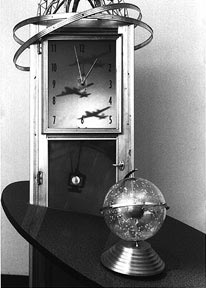3SC: Ken Feingold: Childhood / Hot & Cold Wars (The Appearance of Nature)
1992-93

At the center of my work Childhood / Hot & Cold Wars (The Appearance of Nature) I have undertaken a search for my childhood tv memories, a kind of archeology of those images and sounds which I remember, or see now, as having been formative in my personal understanding of what was "going on" in the world. I grew up watching television. Some of my earliest and most vivid sensory and emotional memories are of television programs I saw in my first years. The themes of my childhood emerged amid ever-present references to World War III, the atom bomb, the Communist Threat and the Domino Theory, intersected by the emergence of suburbia, Sputnik, the Space Race and promises of endless progress in a fantastic technological future in which I would be visiting other worlds. These recurring themes were played out through tv characters, news, advertisements, science fiction films, children's programs, and Civil Defense films - a strange mixture of cartoon violence, sci-fi monsters, cowboys and Indians, and "air raid drills". In school and at home, we practiced for nuclear attack, and watched people, monsters, and cartoon animals killing each other on tv. It seemed natural, the way things were. I was learning, in a way, to learn violence as the language of the world, as a kind of entertainment.
The work is a complex, hybrid object; it has aspects of a "grandfather clock," intersected by a Formica dining table, parts of a suburban tract house, and the roof is a replica of the Hiroshima building called the A-bomb Dome, a surviving skeleton which now stands as a memorial. The object is made primarily of aluminum, approximately 7 feet high. The face of the clock has numbers and hands as an ordinary clock, but this face is also a screen upon which the video images are rear-projected from within the body of the clock. The front of the clock body is a typical 50's "screen door" (also referring to the tv/cinema screen, and "screen memories" - so important to this work), made from the actual door of my parents' home. Intersecting the body of the clock is a skewed dining table. On it sits a globe - a transparent celestial globe mapping the heavens, with a smaller earth globe within it. Behind the globe, below the clock-face, is a window through which a small tele-pendulum marks seconds with each swing. Standing alone, the work plays these tv fragments as if "ticking" on the clock face. Playing like a step-frame animation, at one field per second, one sees sequences of still images. It takes 24 hours to play its full cycle of images and sounds in this manner.
The work has interactive aspects. It has been organized in such a way that a viewer who becomes physically involved with the work - by turning the globe - affects the ways in which the tv images and sounds are played, and may move through them forward and back in time. The circuits and software I have made respond to gestures and types of movements, rather than simply following the participant's spinning as a "trackball" might. Like fragments of early memories, disconnected, crystal-clear, momentary - the "seconds, minutes, and hours" in this work are stretched to infinity, going around over and over (as in my mind) with the hands of the clock, changing through the interaction of a viewer-participant, or going along without them. Forgetting, returning, forgetting, returning...
kf 1993